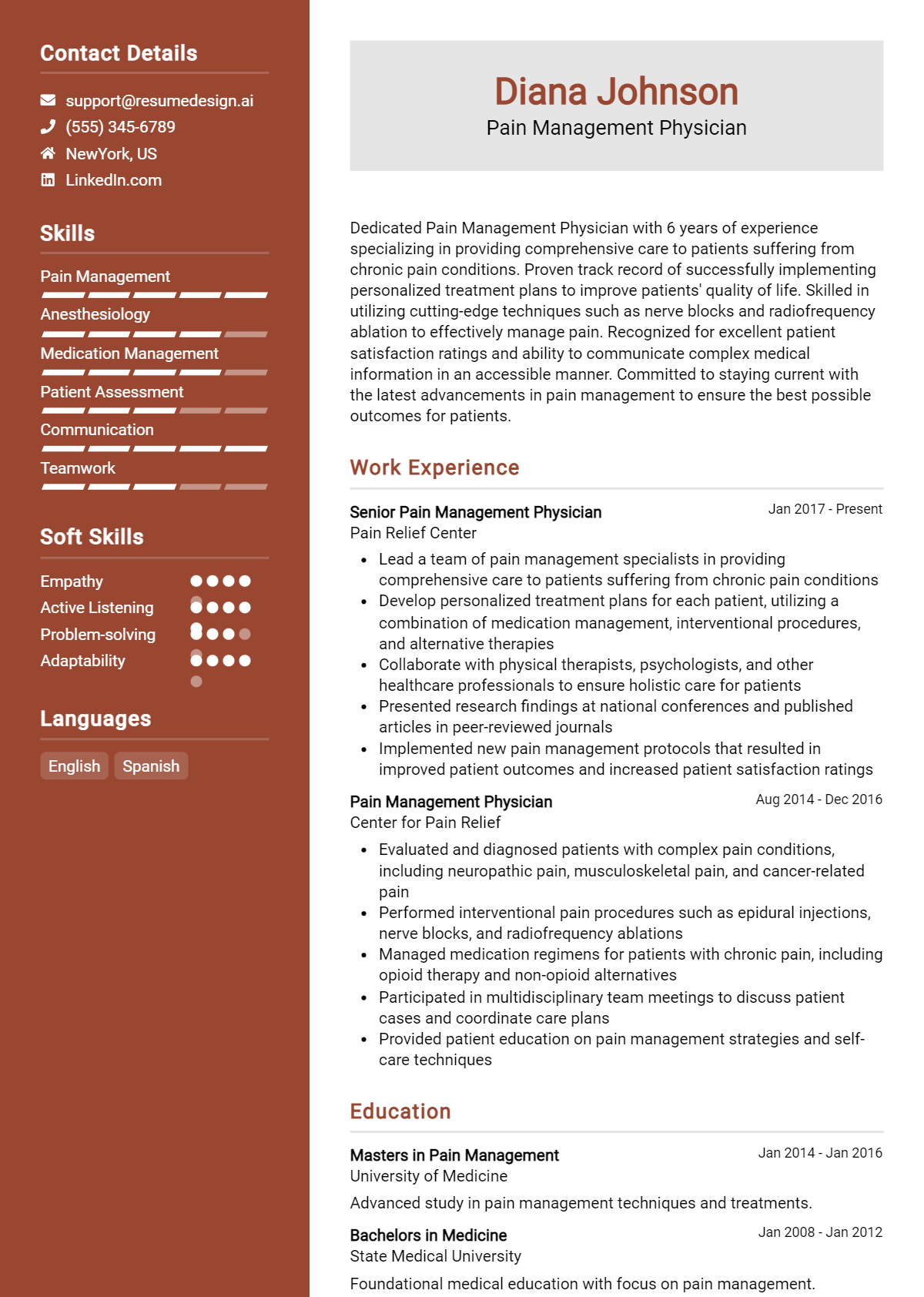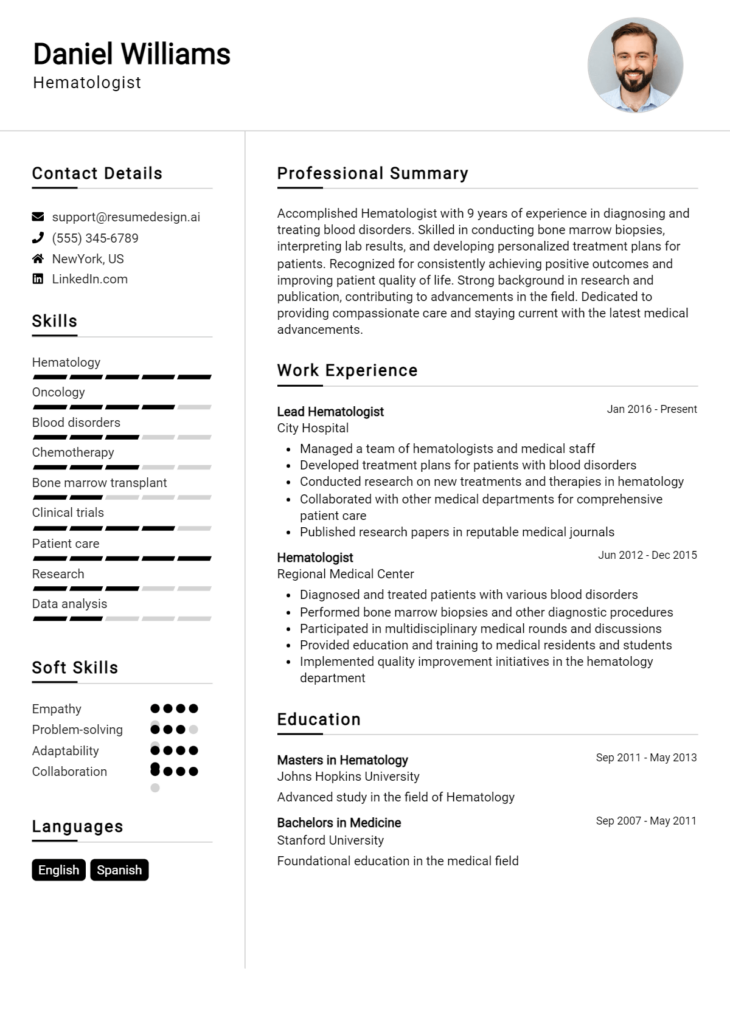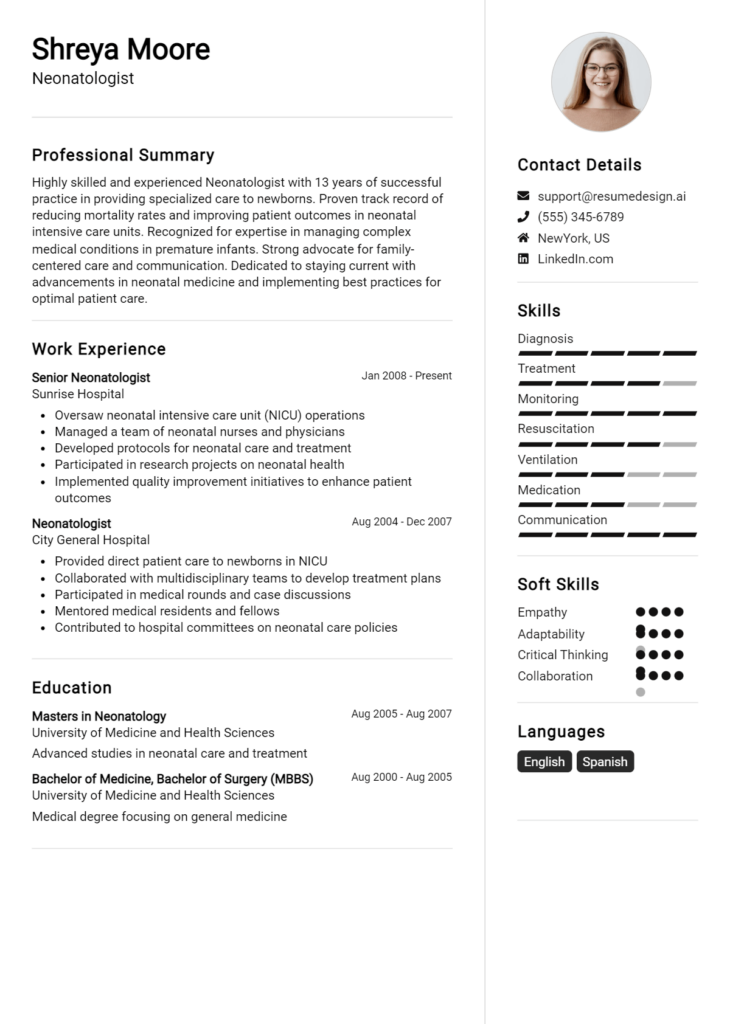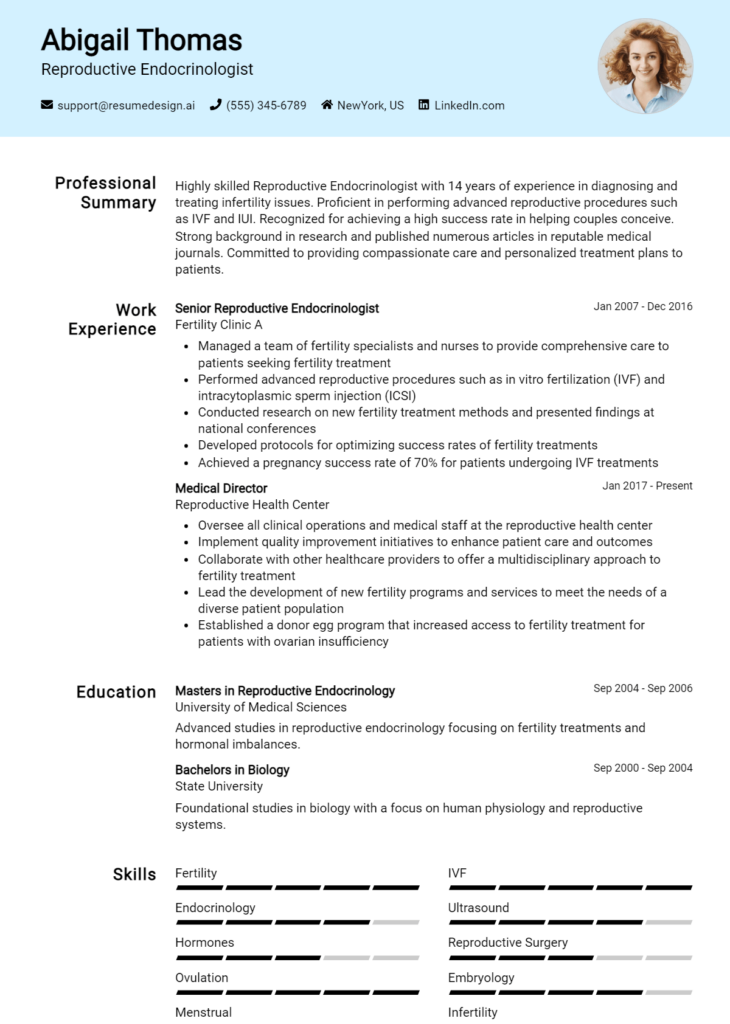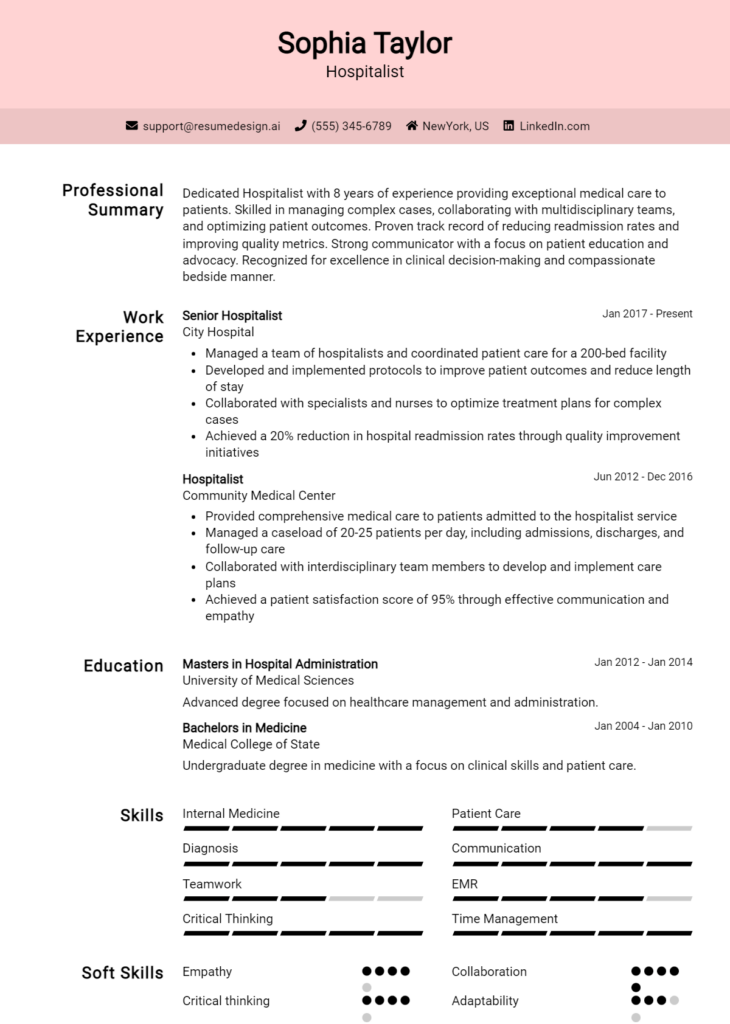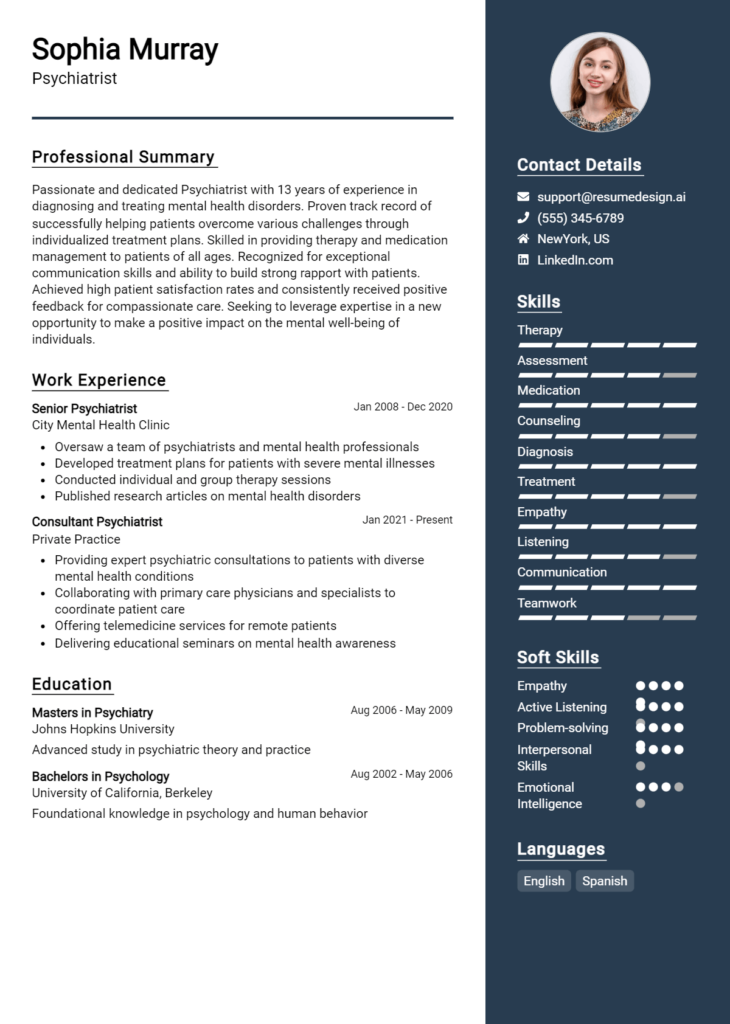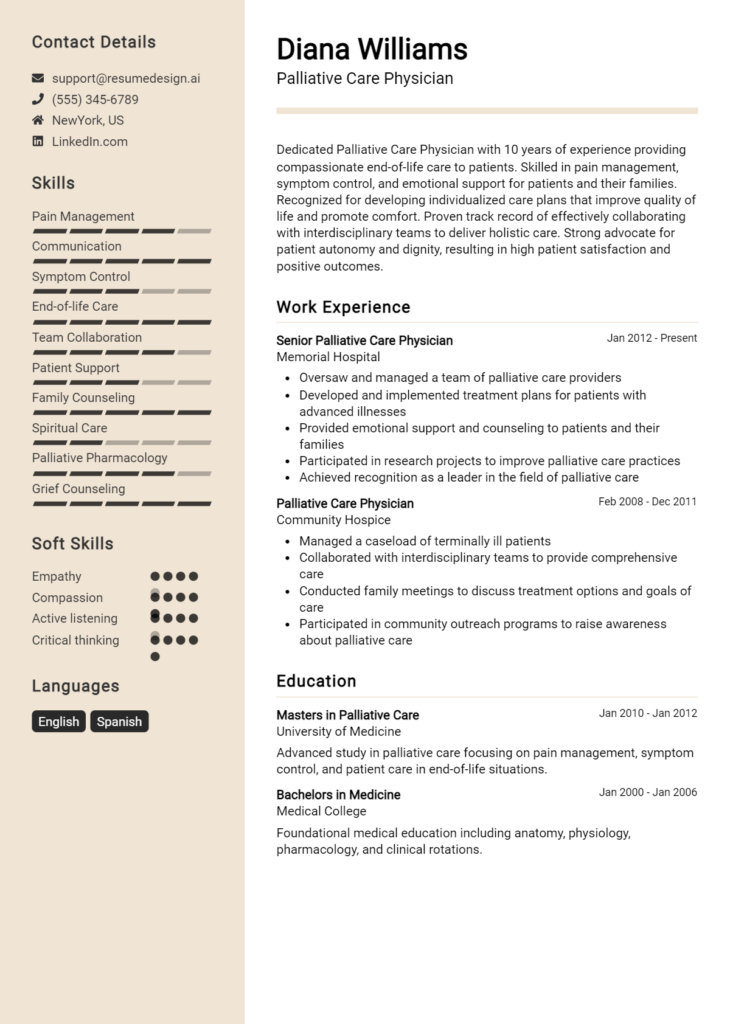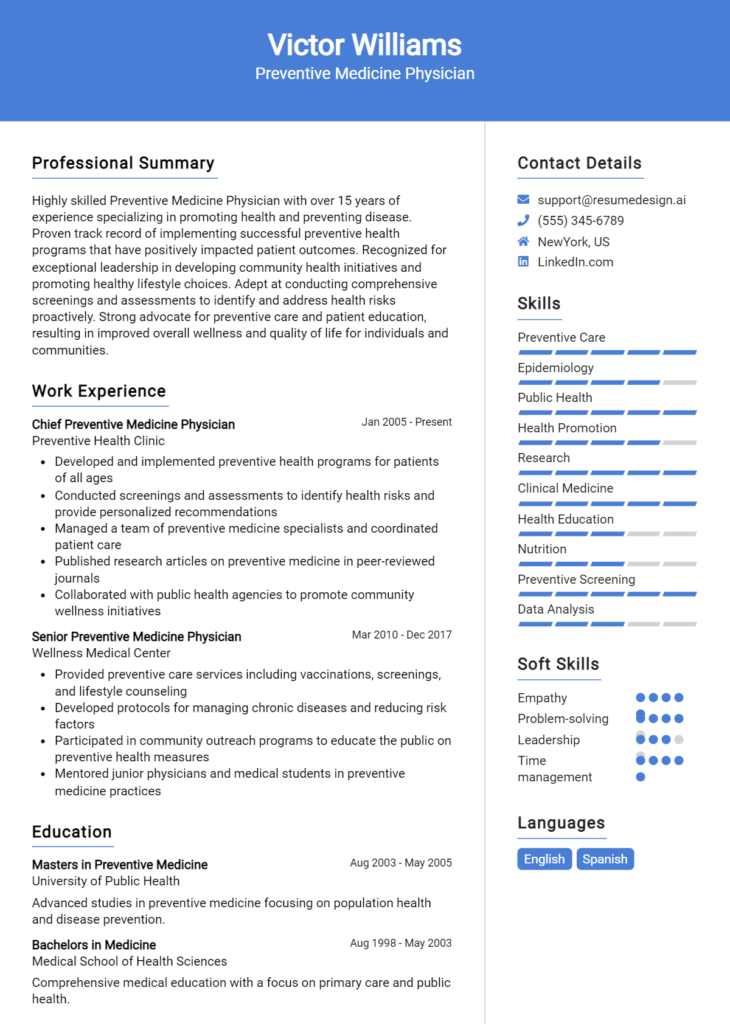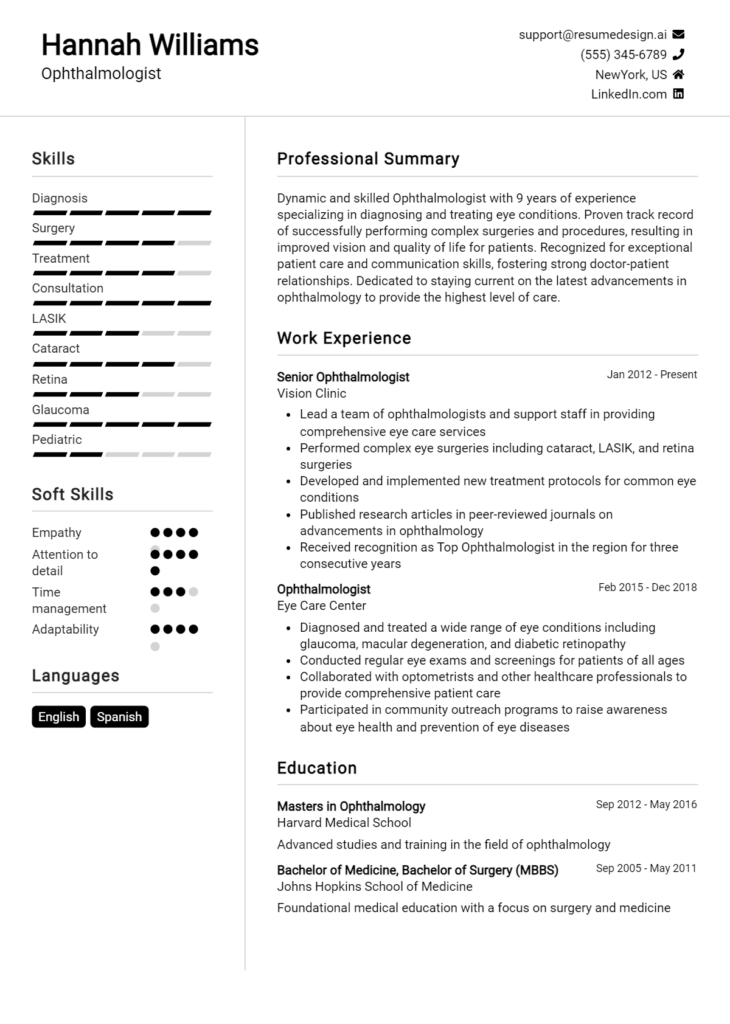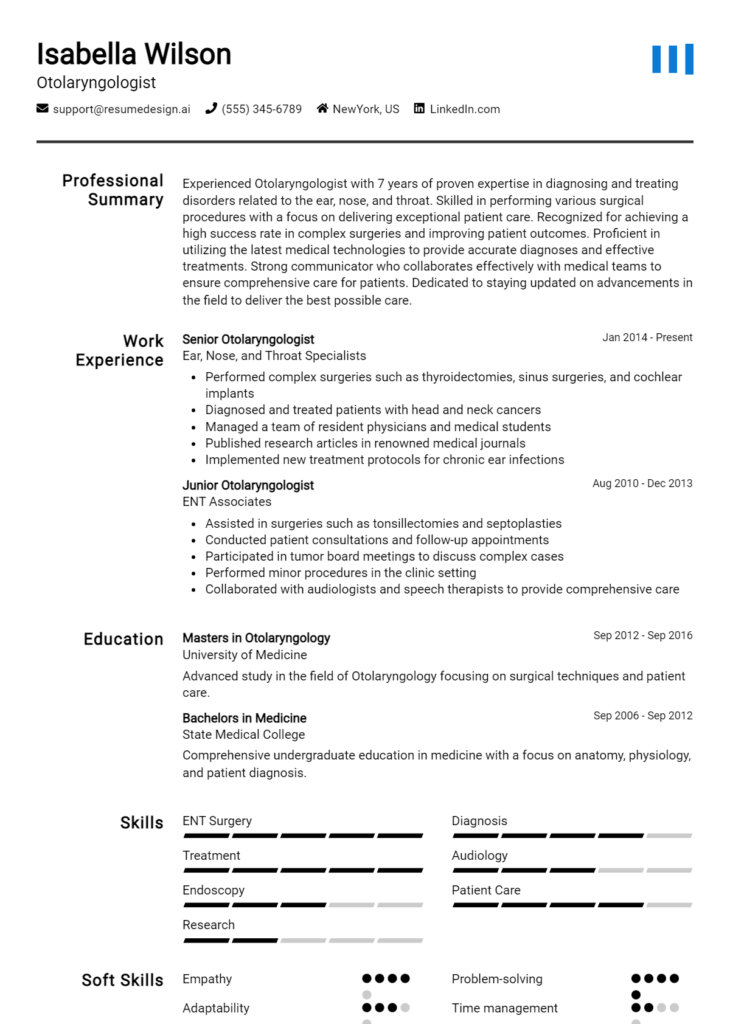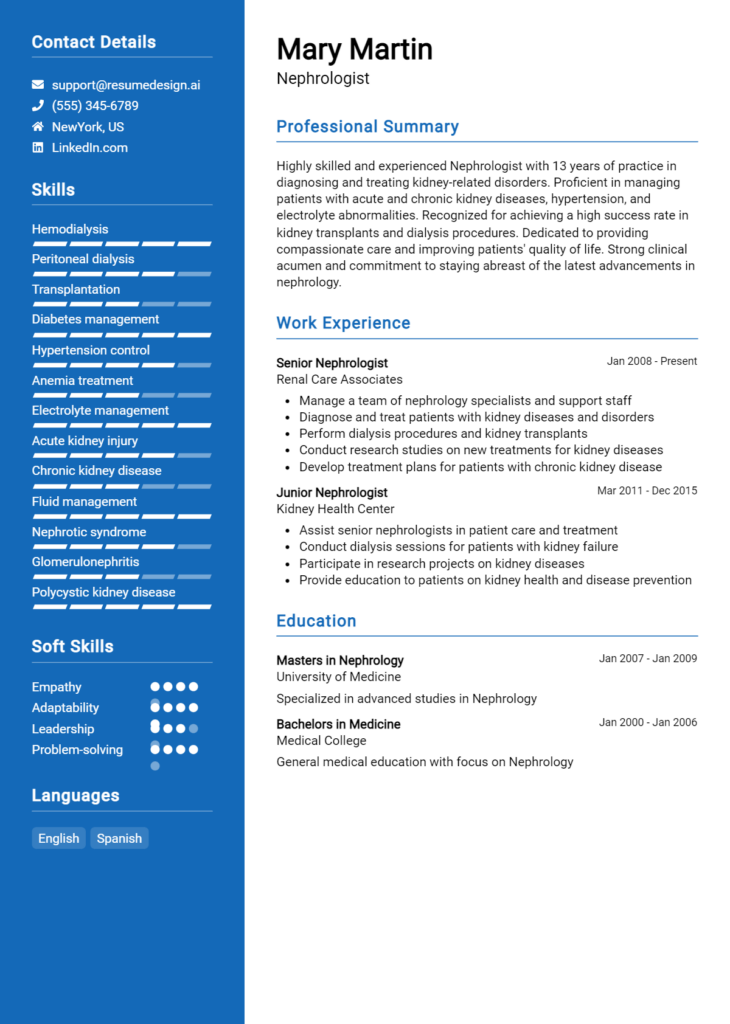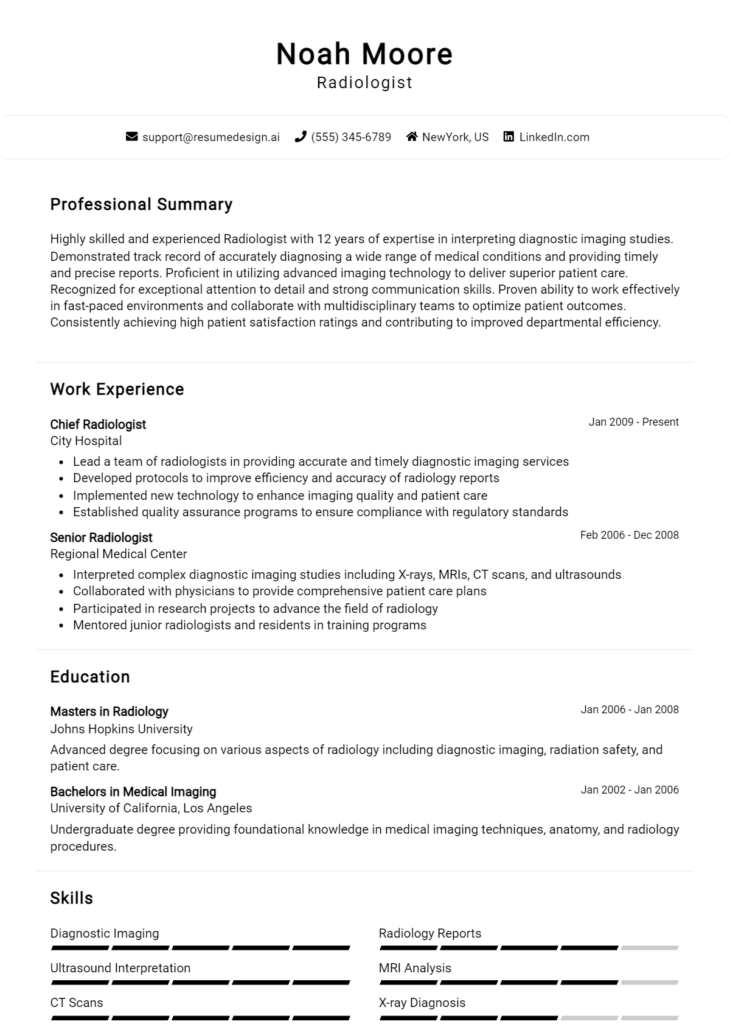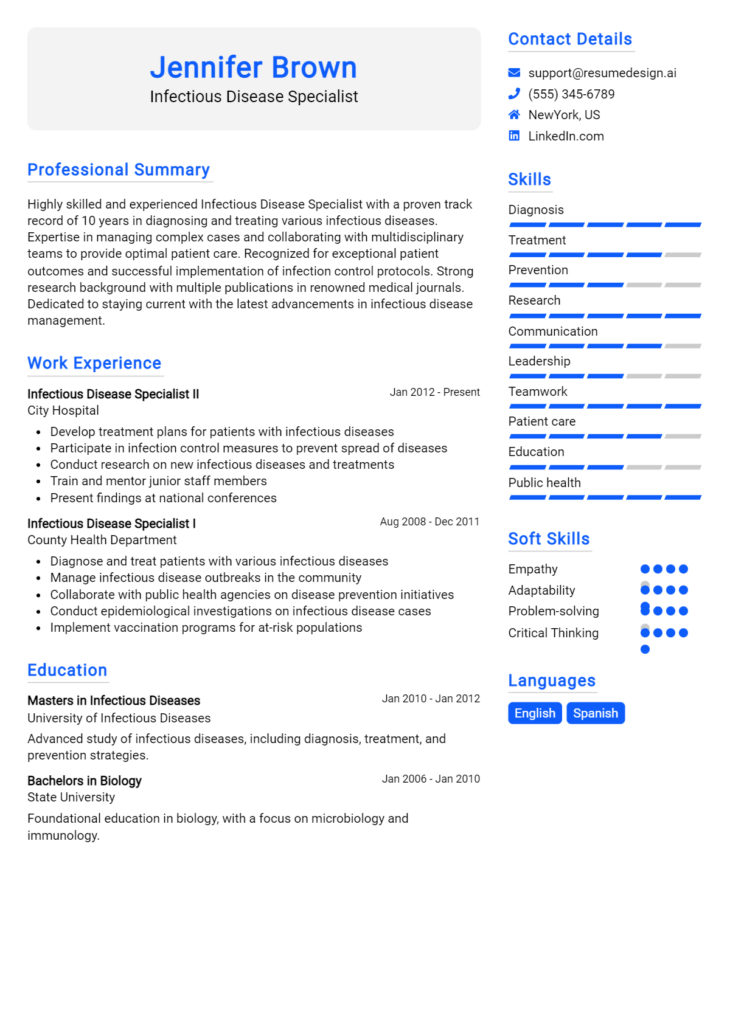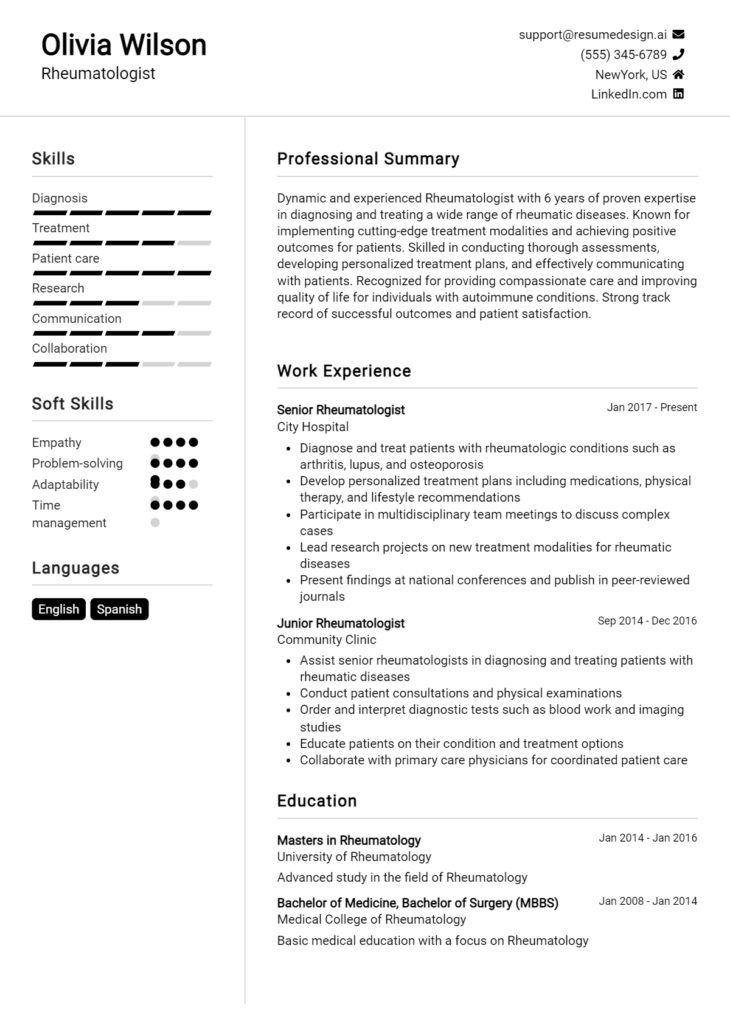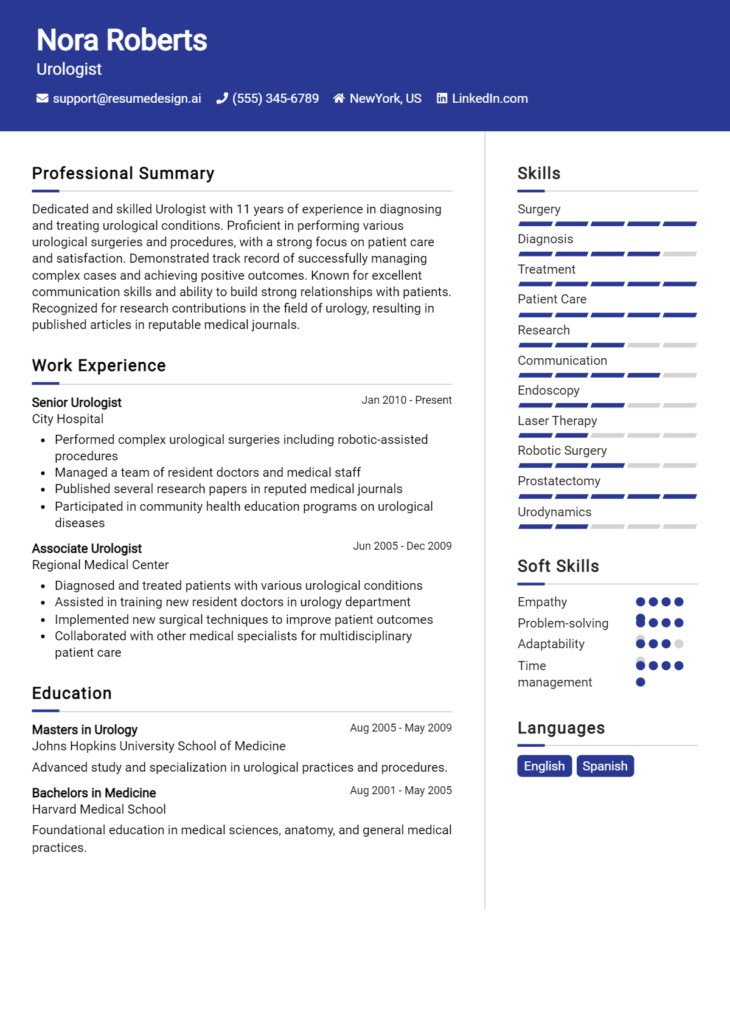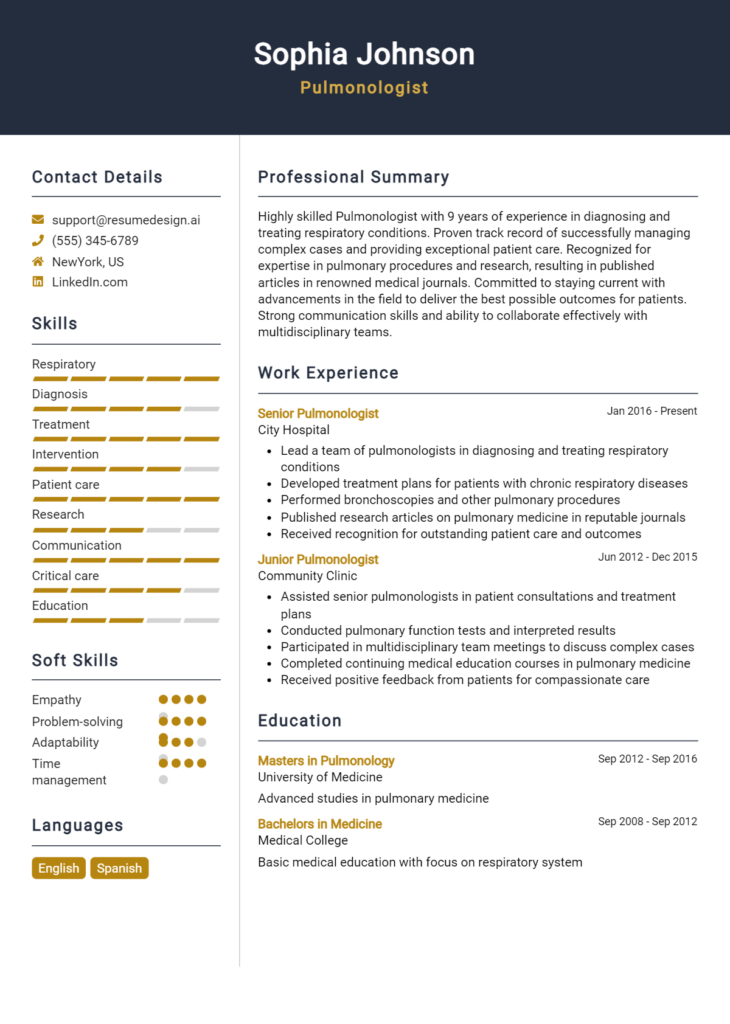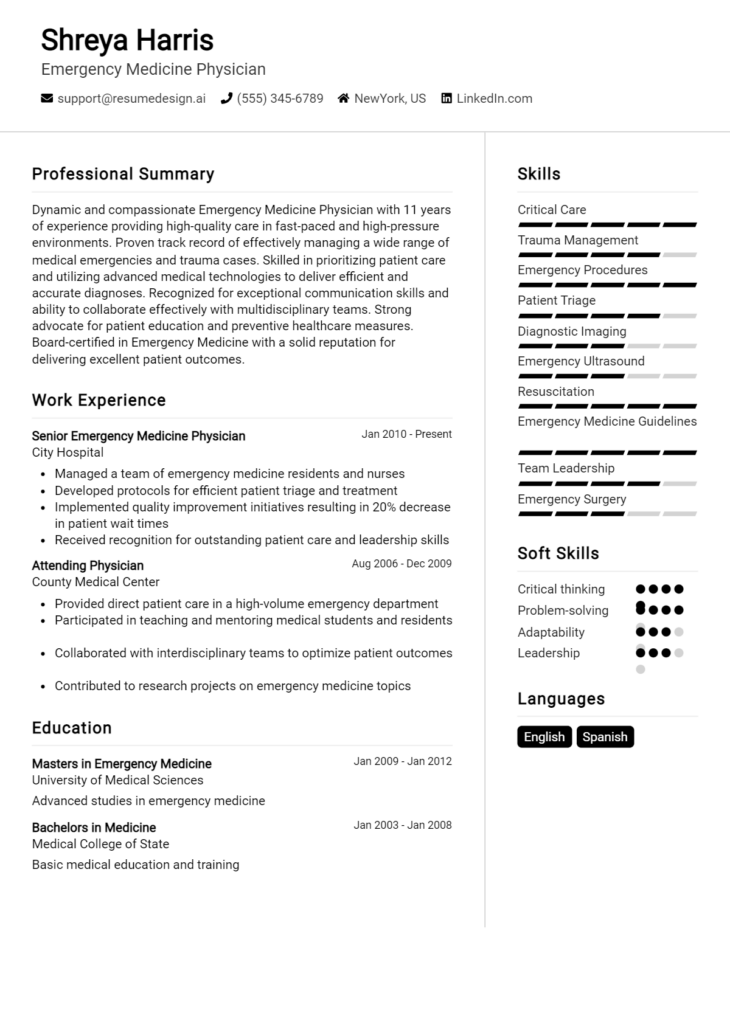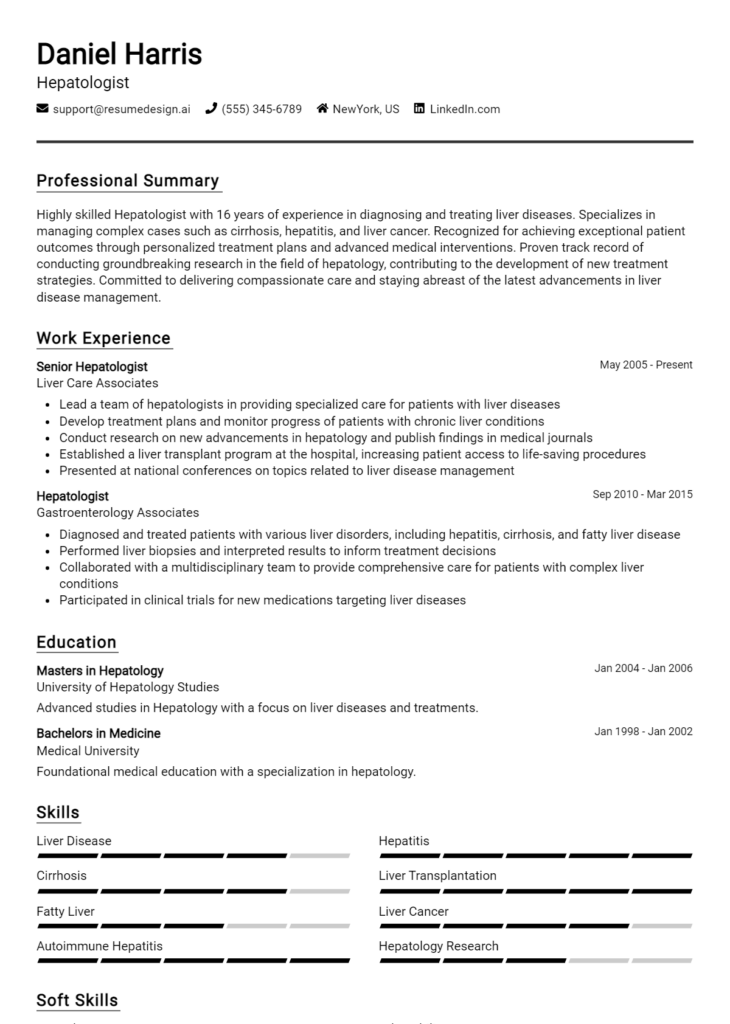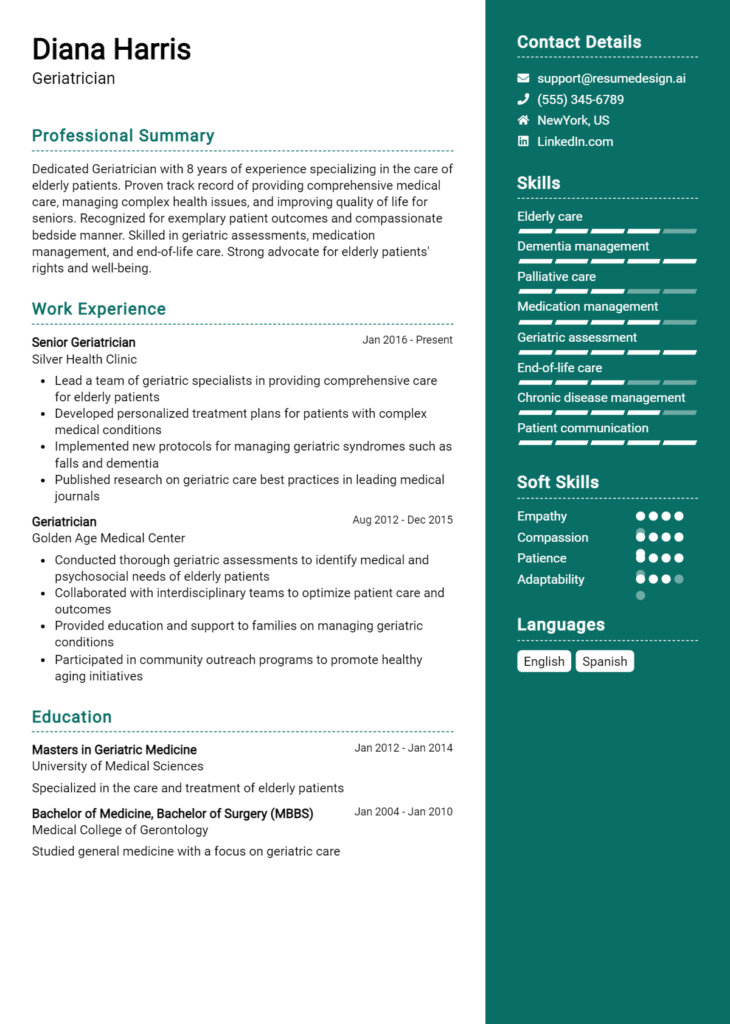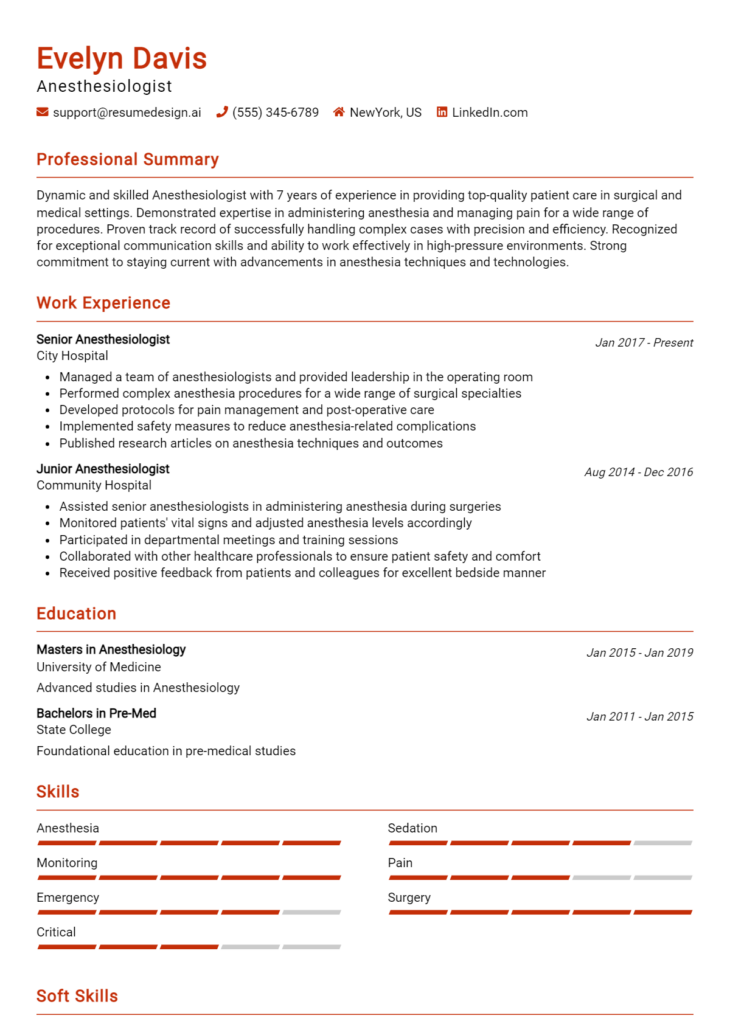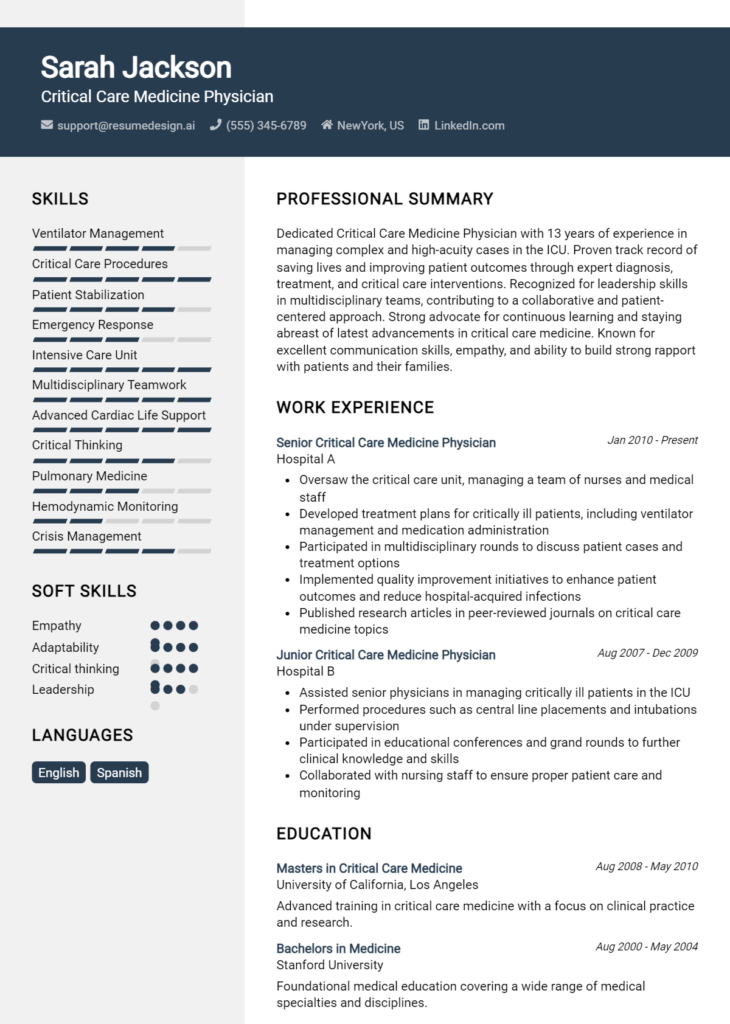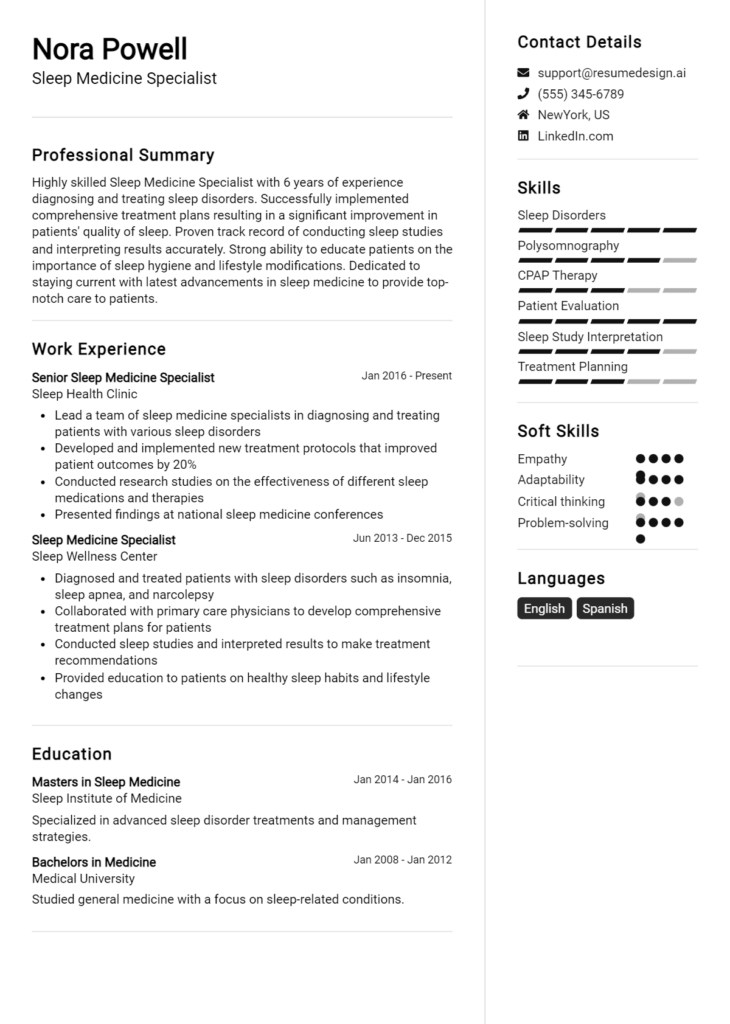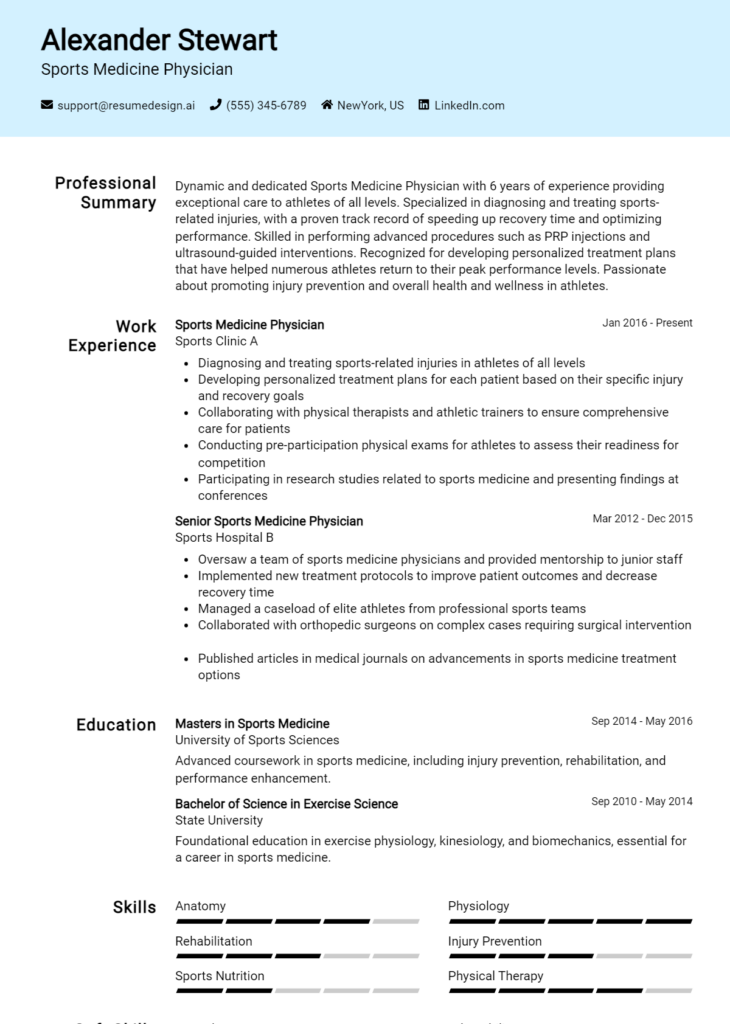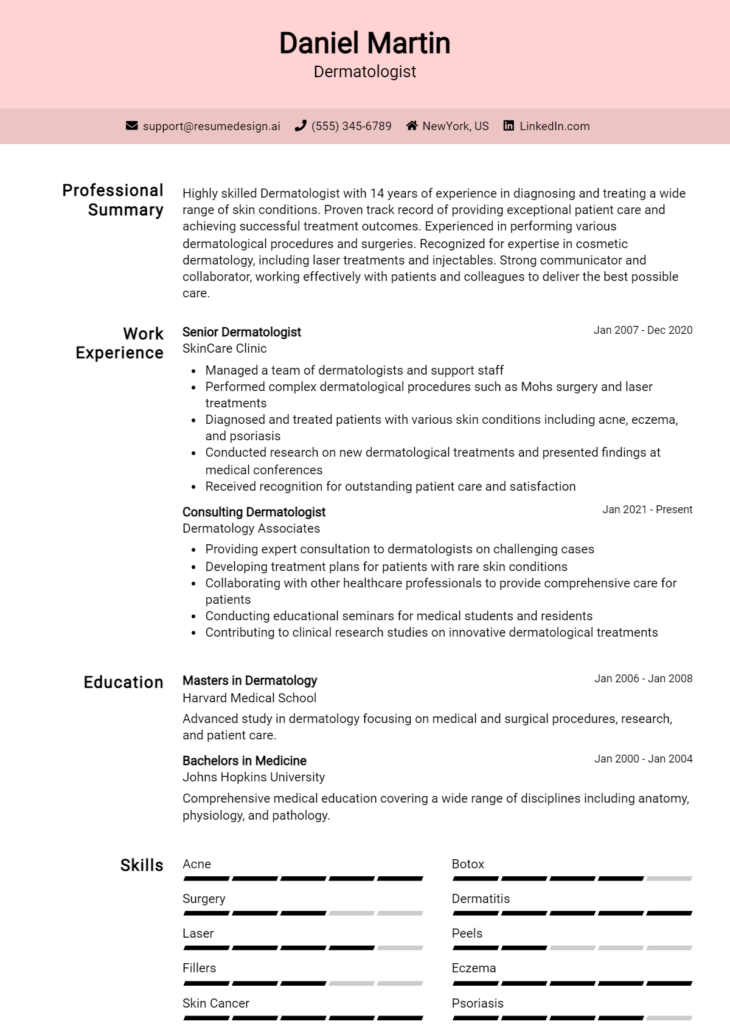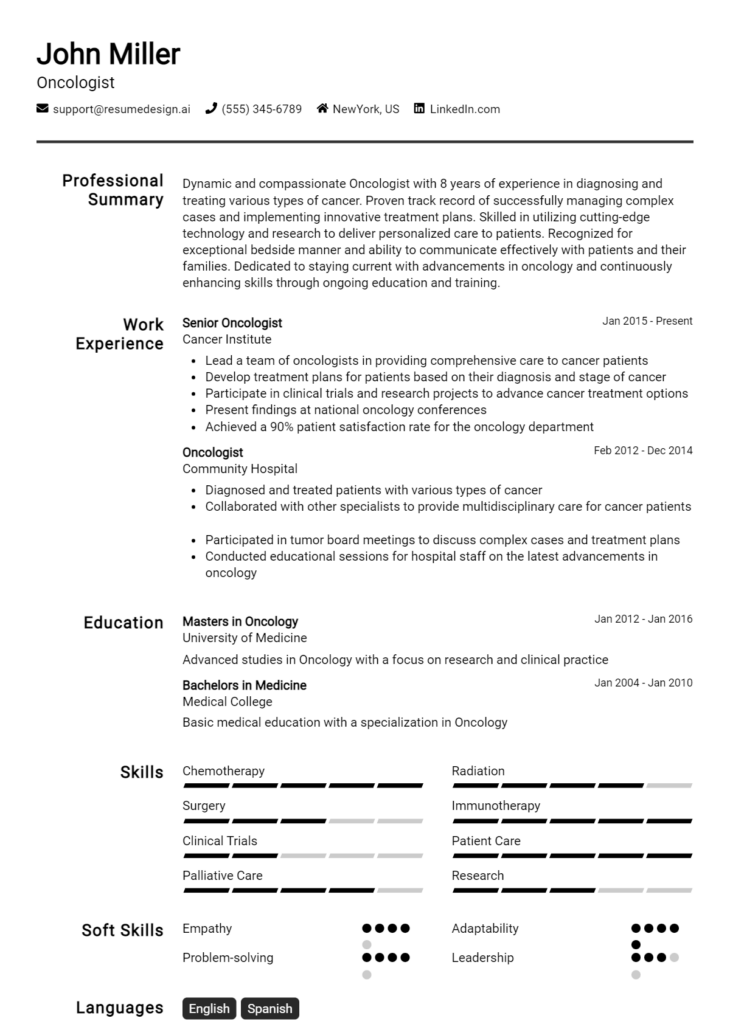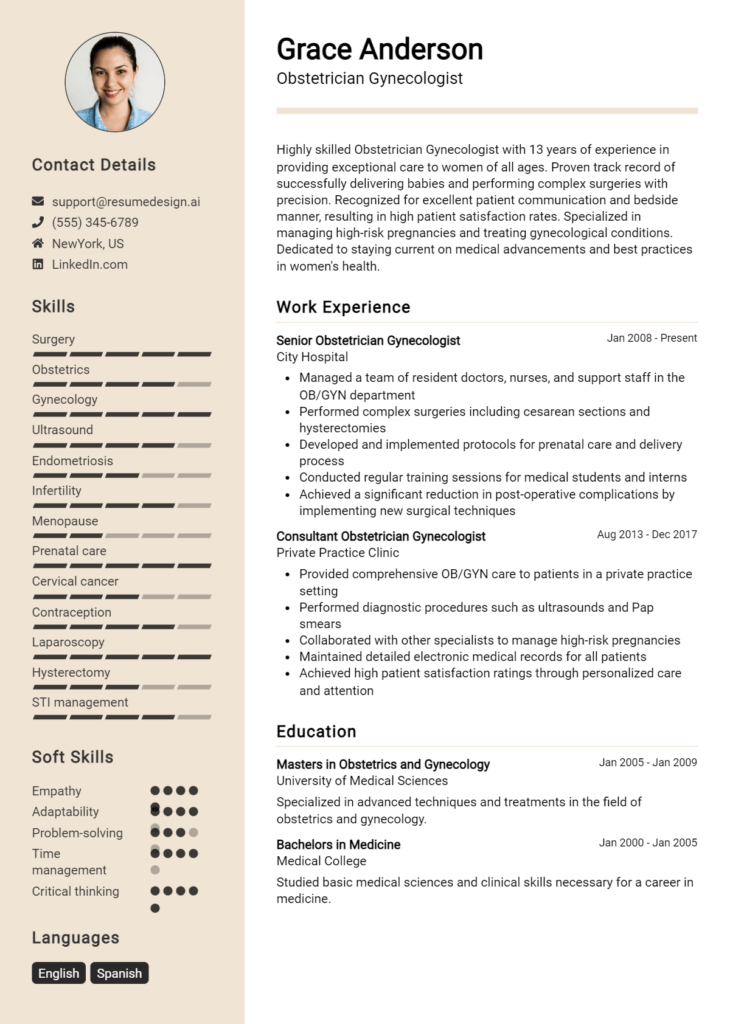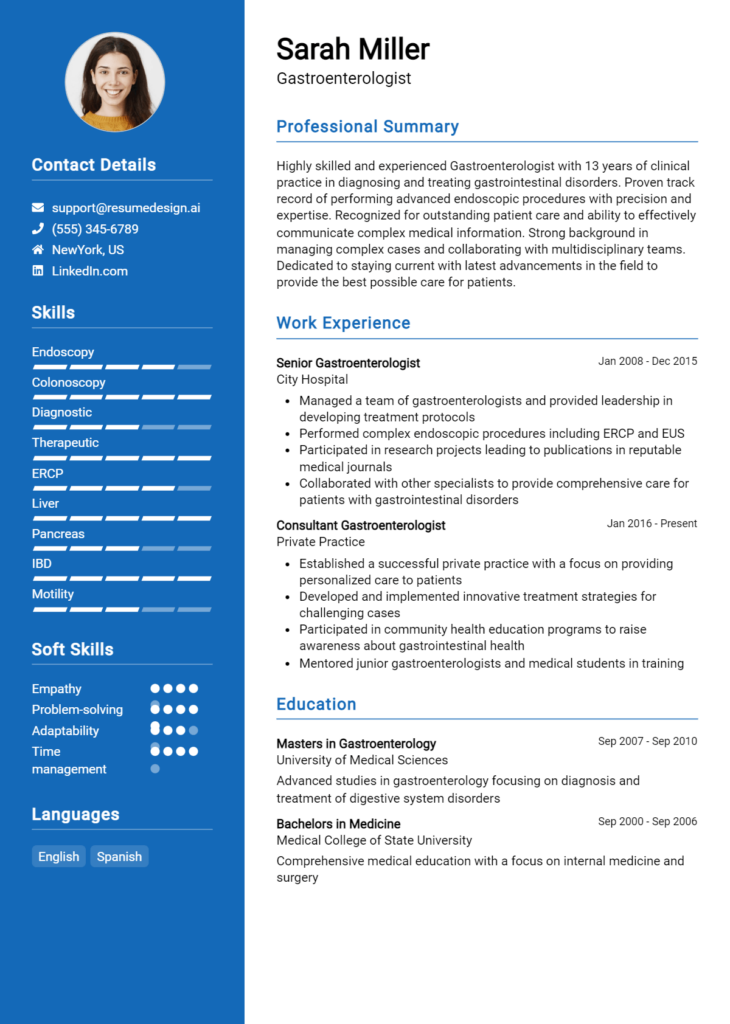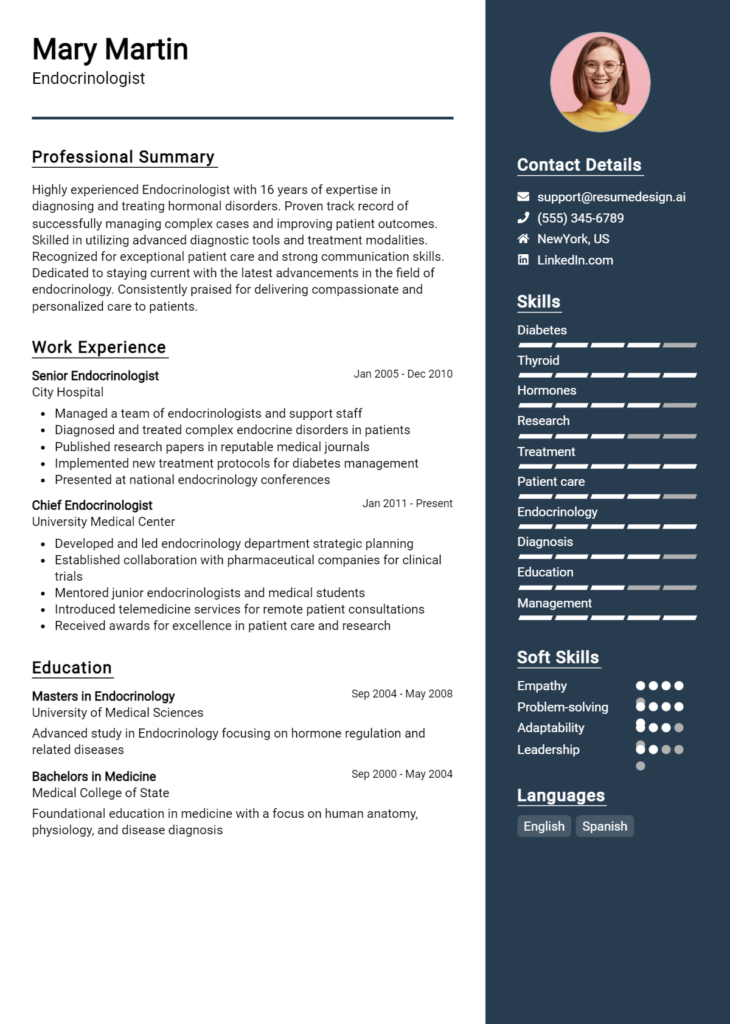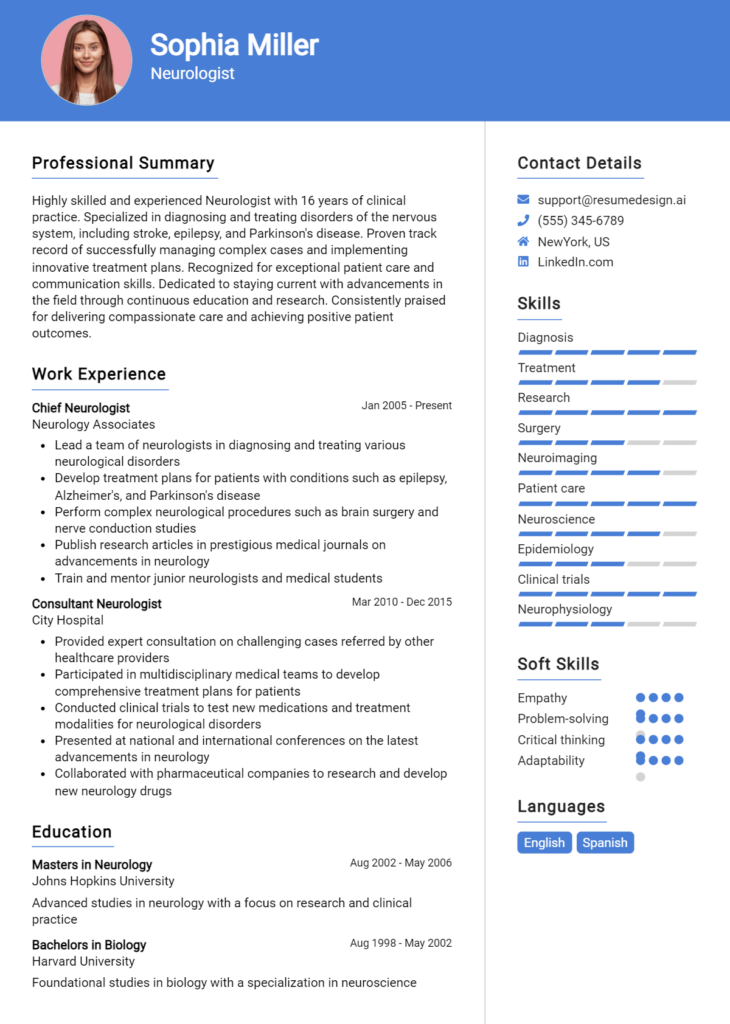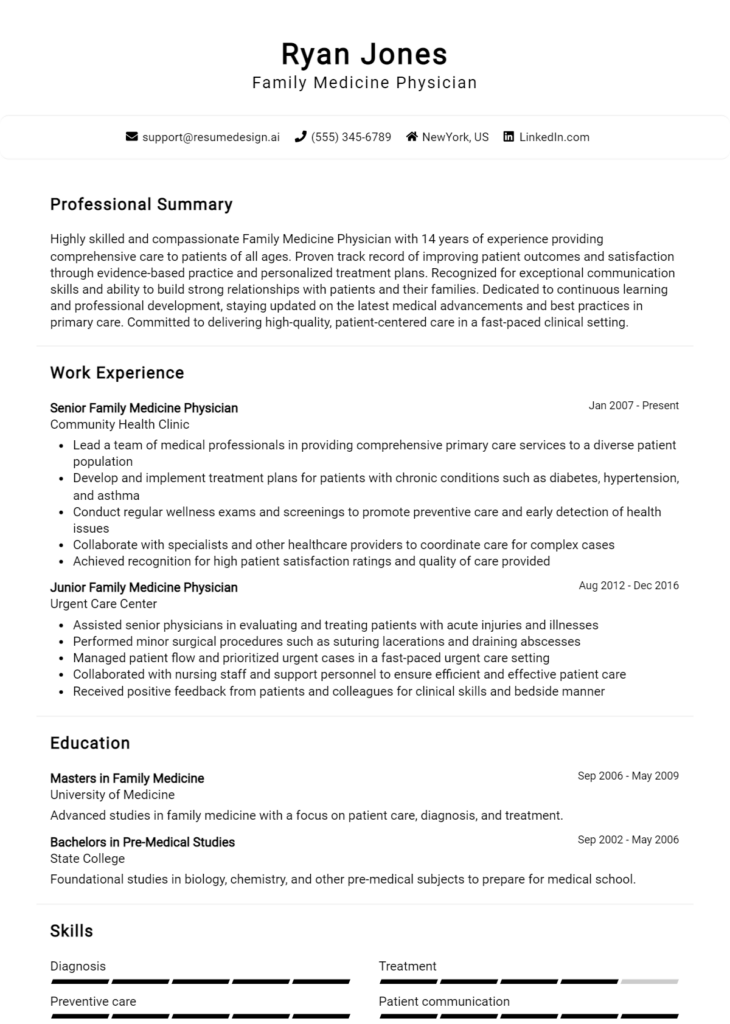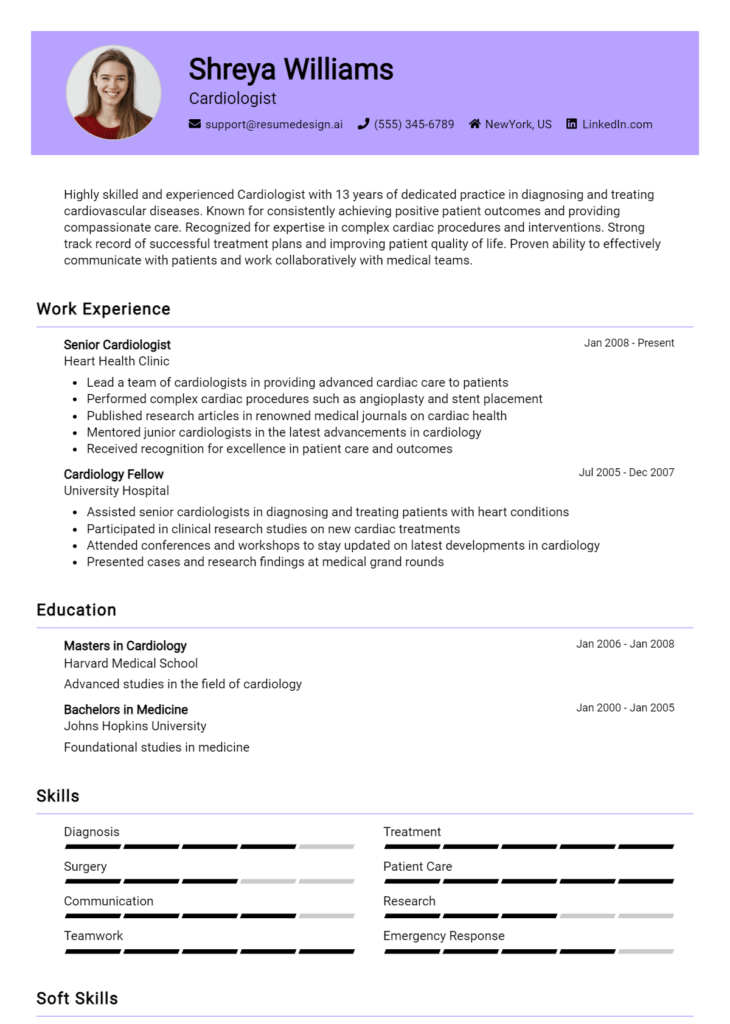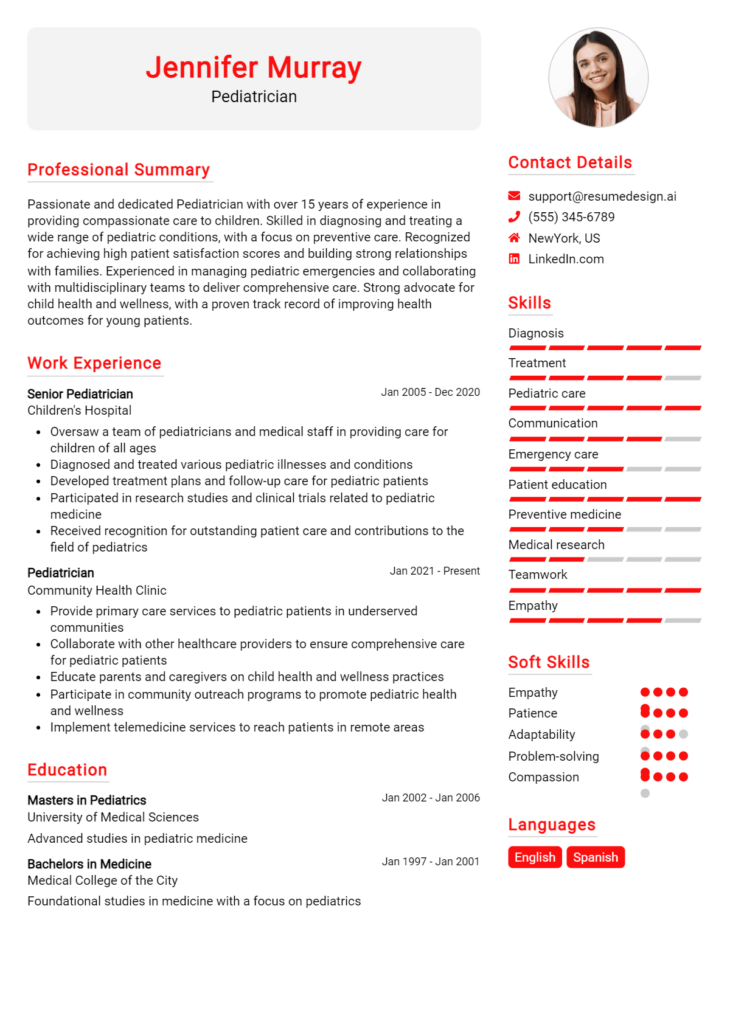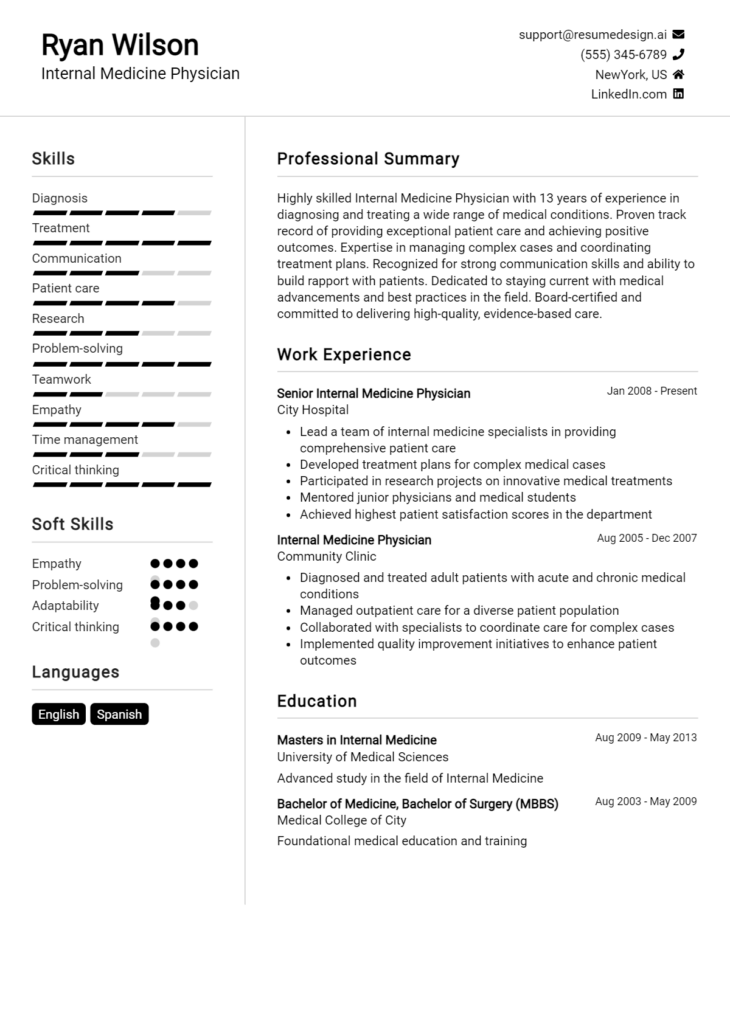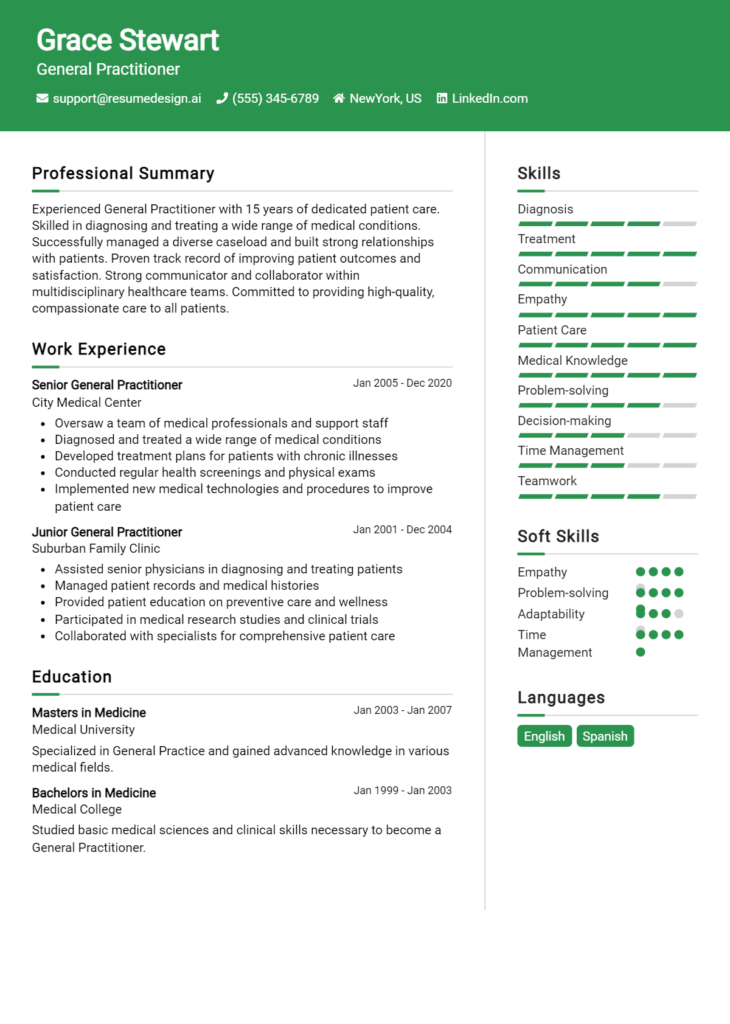Pain Management Physician Core Responsibilities
A Pain Management Physician plays a crucial role in diagnosing and treating patients suffering from chronic pain, requiring a blend of technical expertise and strong problem-solving skills. They collaborate with various departments, including physical therapy, psychology, and rehabilitation, to create comprehensive treatment plans that address the multifaceted nature of pain. Operational skills are vital for managing patient care effectively, ensuring adherence to protocols, and maintaining accurate records. A well-structured resume can highlight these essential qualifications, demonstrating how they align with the organization’s goals of enhancing patient well-being and operational efficiency.
Common Responsibilities Listed on Pain Management Physician Resume
- Conduct comprehensive assessments of patients’ pain conditions.
- Develop and implement individualized pain management plans.
- Administer pain-relieving injections and other interventional procedures.
- Collaborate with multidisciplinary teams for holistic patient care.
- Monitor and evaluate patient responses to treatments.
- Educate patients on pain management techniques and lifestyle modifications.
- Maintain accurate medical records and documentation.
- Stay updated on advancements in pain management therapies.
- Advise on medication management and potential side effects.
- Participate in research and clinical trials related to pain management.
- Provide guidance to healthcare staff on pain management best practices.
High-Level Resume Tips for Pain Management Physician Professionals
In the competitive field of pain management, a well-crafted resume is crucial for standing out among numerous qualified candidates. As a Pain Management Physician, your resume often serves as the first impression you make on potential employers, making it imperative that it effectively reflects your skills, experiences, and achievements. A strong resume should not only showcase your medical expertise but also highlight your ability to provide compassionate care and innovative solutions for pain relief. This guide will provide practical and actionable tips specifically tailored for Pain Management Physician professionals, enabling you to create a resume that resonates with hiring managers and sets you apart in the job market.
Top Resume Tips for Pain Management Physician Professionals
- Tailor your resume to the job description by using relevant keywords and phrases from the posting.
- Highlight your clinical experience in pain management, including specific procedures and therapies you specialize in.
- Quantify your achievements, such as the number of patients treated, success rates, or improvements in patient quality of life.
- Include certifications and licenses that are pertinent to pain management, ensuring they are up-to-date.
- Showcase your ability to work in multidisciplinary teams and collaborate with other healthcare professionals.
- Emphasize any research contributions, publications, or presentations related to pain management or relevant medical topics.
- Detail your experience with patient education and communication, showcasing how you empower patients in managing their pain.
- Incorporate any specialized training or workshops that enhance your skills in pain management techniques.
- Use a clean, professional format to improve readability and make a lasting impression on potential employers.
- Consider including a brief summary or objective statement that encapsulates your professional philosophy and goals in pain management.
By implementing these tailored tips, you can significantly increase your chances of landing a job in the Pain Management Physician field. A strategically crafted resume not only highlights your qualifications but also communicates your dedication to improving patient outcomes, making you a compelling candidate for potential employers.
Why Resume Headlines & Titles are Important for Pain Management Physician
In the competitive field of pain management, resume headlines and titles play a crucial role in capturing the attention of hiring managers. A strong headline or title can serve as a powerful first impression, summarizing a candidate's key qualifications in one impactful phrase. This concise and relevant statement not only highlights the candidate's expertise but also aligns directly with the specific job being applied for. By effectively showcasing their strengths, a well-crafted headline can set the tone for the entire resume, helping candidates stand out in a crowded applicant pool.
Best Practices for Crafting Resume Headlines for Pain Management Physician
- Keep it concise: Aim for a single, powerful phrase that conveys your expertise.
- Be specific: Tailor your headline to reflect the role of a pain management physician.
- Highlight key skills: Focus on your most relevant skills and accomplishments.
- Use industry-related keywords: Incorporate terms that are familiar within the pain management field.
- Showcase your years of experience: If applicable, mention your years in the field to establish credibility.
- Reflect your approach to patient care: Consider including your philosophy or unique approach.
- Avoid jargon: Use clear language that is easy to understand for hiring managers.
- Make it impactful: Choose words that convey strength and confidence in your abilities.
Example Resume Headlines for Pain Management Physician
Strong Resume Headlines
Dedicated Pain Management Physician with 10+ Years of Experience in Multimodal Treatment Approaches
Compassionate Pain Management Specialist Committed to Improving Patient Quality of Life Through Innovative Therapies
Board-Certified Pain Management Physician Focused on Evidence-Based Practices and Patient-Centered Care
Weak Resume Headlines
Physician Looking for Job
Experienced Doctor in Healthcare
Strong headlines are effective because they provide a clear and specific snapshot of a candidate’s qualifications, making it easy for hiring managers to quickly assess their fit for the role. They communicate expertise and a commitment to patient care while using industry-relevant terminology. On the other hand, weak headlines fail to impress because they are vague and lack specificity, leaving hiring managers unsure of the candidate's actual qualifications and relevance to the pain management field. By avoiding generic phrases, candidates can ensure their resumes stand out and resonate with potential employers.
Writing an Exceptional Pain Management Physician Resume Summary
A well-crafted resume summary is crucial for a Pain Management Physician as it serves as the first impression to hiring managers. In a competitive job market, a strong summary quickly captures attention by effectively showcasing key skills, significant experience, and noteworthy accomplishments relevant to the role. It should be concise and impactful, tailored specifically to the job description, allowing the candidate to stand out among applicants. A compelling resume summary can set the tone for the entire resume, highlighting the candidate's suitability for the position right from the start.
Best Practices for Writing a Pain Management Physician Resume Summary
- Quantify Achievements: Use numbers to demonstrate your impact, such as the number of patients treated or improvement rates.
- Focus on Relevant Skills: Highlight specific skills that are crucial for pain management, such as interventional techniques or patient assessment.
- Tailor the Summary: Customize your summary for each job application to align with the specific qualifications and requirements outlined in the job description.
- Use Action Verbs: Start sentences with strong action verbs to convey energy and initiative.
- Showcase Key Accomplishments: Include notable achievements that emphasize your expertise and contributions to past employers.
- Keep it Concise: Aim for 3-5 sentences that clearly communicate your value without unnecessary fluff.
- Incorporate Industry Language: Use terminology common in pain management to demonstrate your familiarity with the field.
- Reflect on Patient Outcomes: Discuss how your work has directly improved patient quality of life or pain management efficacy.
Example Pain Management Physician Resume Summaries
Strong Resume Summaries
Compassionate Pain Management Physician with over 8 years of experience in diagnosing and treating chronic pain conditions. Successfully increased patient satisfaction scores by 30% through the implementation of individualized pain management plans and innovative treatment protocols.
Board-Certified Pain Management Specialist with a proven track record of utilizing interventional pain management techniques to reduce patient pain levels by an average of 40%. Committed to providing high-quality patient care and improving functional outcomes through comprehensive assessments.
Dedicated Pain Management Physician with expertise in multimodal pain management strategies, having treated over 1,500 patients in diverse clinical settings. Known for developing pain management programs that reduced opioid prescriptions by 25%, promoting safer, effective alternatives.
Weak Resume Summaries
Experienced physician looking for a position in pain management. I have treated many patients and have a good understanding of the field.
I am a doctor who has been working in pain management for a while. I am passionate about helping patients and want to find a new job in this area.
The examples of strong resume summaries are effective because they include quantifiable results, specific skills, and relevant experience, demonstrating a clear fit for the role. In contrast, the weak summaries lack specificity, fail to mention measurable outcomes, and appear generic, making it difficult for hiring managers to gauge the candidate's qualifications or impact in previous roles.
Work Experience Section for Pain Management Physician Resume
The work experience section of a Pain Management Physician resume is critical as it serves as a comprehensive showcase of the candidate's technical skills, leadership abilities, and commitment to delivering high-quality care. This section allows prospective employers to assess not only the physician's clinical expertise but also their ability to manage teams effectively and collaborate with other healthcare professionals. By quantifying achievements and aligning experiences with industry standards, candidates can demonstrate their impact in previous roles, making a compelling case for their suitability for the position.
Best Practices for Pain Management Physician Work Experience
- Detail specific pain management techniques and technologies utilized in previous roles.
- Quantify patient outcomes, such as percentage reductions in pain levels or improvements in quality of life.
- Highlight leadership roles in multidisciplinary teams, showcasing collaboration and communication skills.
- Include relevant certifications and training that demonstrate ongoing professional development.
- Emphasize the implementation of evidence-based practices and their results in patient care.
- Showcase participation in research or clinical trials that contributed to advancements in pain management.
- Describe involvement in patient education initiatives that enhanced understanding and compliance.
- Incorporate feedback from patient satisfaction surveys to illustrate commitment to quality care.
Example Work Experiences for Pain Management Physician
Strong Experiences
- Led a multidisciplinary team that achieved a 30% reduction in chronic pain levels among patients through innovative treatment protocols over a one-year period.
- Implemented a new patient education program that resulted in a 40% increase in treatment compliance and a significant improvement in patient satisfaction scores.
- Conducted research on interventional pain management techniques, resulting in a published study that contributed to the field's best practices and enhanced departmental protocols.
- Successfully managed a team of 10 healthcare professionals while overseeing a pain clinic, which saw a 25% increase in patient referrals and positive outcomes.
Weak Experiences
- Worked with patients in a pain management clinic.
- Participated in various team meetings and discussions.
- Provided care for pain-related issues without specifying methods or outcomes.
- Treated patients for pain, contributing to general clinic operations.
The examples listed as strong experiences are considered effective because they clearly quantify achievements, demonstrate leadership in multidisciplinary settings, and highlight the candidate's contributions to improving patient outcomes. In contrast, the weak experiences lack specificity, measurable results, and fail to convey the candidate's impact or specialized skills in pain management, making them less appealing to potential employers.
Education and Certifications Section for Pain Management Physician Resume
The education and certifications section of a Pain Management Physician resume is crucial as it showcases the candidate's academic foundation, specialized training, and commitment to continuous professional development. This section not only highlights relevant degrees and certifications but also demonstrates the candidate's dedication to staying current with industry advancements and best practices. Including pertinent coursework and specialized training can significantly enhance the candidate's credibility, ensuring alignment with the job role and increasing the chances of standing out to potential employers.
Best Practices for Pain Management Physician Education and Certifications
- List degrees in reverse chronological order, starting with the most recent.
- Highlight any specialized training in pain management or related fields.
- Include relevant certifications such as Board Certification in Pain Medicine.
- Provide details about clinical rotations or fellowships in pain management.
- Emphasize continuing medical education (CME) courses completed in pain management.
- Use clear and specific terminology to describe certifications and training.
- Mention any affiliations with professional organizations in pain management.
- Keep the format consistent and easy to read for quick assessment by employers.
Example Education and Certifications for Pain Management Physician
Strong Examples
- Doctor of Medicine (MD) - Harvard Medical School, 2018
- Board Certified in Pain Medicine - American Board of Medical Specialties, 2019
- Fellowship in Pain Management - Johns Hopkins University, 2020
- Advanced Pain Management Techniques - 30-hour CME Course, 2021
Weak Examples
- Bachelor of Arts in Psychology - University of California, 2010
- Certified Nursing Assistant (CNA) - 2015
- Basic Life Support (BLS) Certification - Expired 2020
- Online Workshop on Stress Management - 2019
The strong examples are considered robust because they directly relate to the qualifications and experience required for a Pain Management Physician, showcasing advanced degrees and relevant certifications that reflect a high level of competency in the field. In contrast, the weak examples highlight qualifications that are either irrelevant to the role or outdated, demonstrating a lack of focus on the specific requirements necessary for a successful career in pain management.
Top Skills & Keywords for Pain Management Physician Resume
In the competitive field of pain management, having a well-crafted resume that highlights your skills is essential for standing out among peers. Employers seek candidates who not only possess the technical knowledge required to diagnose and treat pain but also demonstrate competencies that enhance patient interactions and overall care. A strong resume for a Pain Management Physician should reflect both hard and soft skills, as these attributes are critical to delivering effective treatment plans and fostering trust with patients. Showcasing these skills not only provides insight into your capabilities but also aligns with the expectations set forth in the industry.
Top Hard & Soft Skills for Pain Management Physician
Soft Skills
- Empathy
- Communication Skills
- Active Listening
- Problem Solving
- Team Collaboration
- Patient Advocacy
- Emotional Intelligence
- Time Management
- Adaptability
- Critical Thinking
- Conflict Resolution
- Attention to Detail
- Professionalism
- Interpersonal Skills
- Cultural Competence
Hard Skills
- Pain Assessment Techniques
- Advanced Interventional Procedures
- Knowledge of Pain Management Pharmaceuticals
- Fluoroscopy and Imaging Techniques
- Patient Evaluation & Diagnosis
- Electronic Health Records (EHR) Management
- Familiarity with Regulatory Guidelines
- Physical Therapy Coordination
- Multidisciplinary Treatment Planning
- Research and Clinical Trials
- Evidence-Based Practice
- Procedural Competence (e.g., epidurals, nerve blocks)
- Computer Proficiency (e.g., Microsoft Office, medical software)
- Statistical Analysis
- Familiarity with Medical Coding and Billing
For more insights on how to effectively present your skills and work experience in your resume, consider tailoring the content to reflect your unique qualifications and contributions to the field of pain management.
Stand Out with a Winning Pain Management Physician Cover Letter
I am writing to express my interest in the Pain Management Physician position at [Institution/Practice Name], as advertised on [Job Board/Website]. With my extensive training in anesthesiology and pain medicine, coupled with over [X years] of clinical experience in diagnosing and treating a wide range of chronic pain conditions, I am confident in my ability to contribute effectively to your team and provide exceptional care to your patients. My commitment to a multidisciplinary approach in pain management aligns perfectly with your organization’s mission to deliver comprehensive and compassionate healthcare.
Throughout my career, I have developed a robust skill set in various interventional pain management techniques, including epidural steroid injections, nerve blocks, and radiofrequency ablation. At [Previous Institution/Practice Name], I successfully managed a diverse patient population, tailoring treatment plans that addressed their unique needs and improving their quality of life. I have also prioritized patient education, ensuring that individuals are informed about their conditions and actively involved in their treatment plans. My dedication to fostering strong patient-provider relationships has led to consistently high satisfaction ratings in my practice.
In addition to my clinical expertise, I am committed to staying current with the latest advancements in pain management. I regularly attend workshops and conferences, and I am an active member of several professional organizations, including the American Academy of Pain Medicine. I believe in the importance of continuous learning and collaboration with colleagues to provide the most effective and up-to-date treatment options for patients. I am excited about the opportunity to bring my passion for pain management and my dedication to patient-centered care to [Institution/Practice Name].
Thank you for considering my application. I look forward to the possibility of discussing how my experience and vision for pain management can align with your team’s goals. I am eager to contribute to your mission of enhancing patient outcomes and improving lives through innovative pain management strategies. Please feel free to contact me at [Your Phone Number] or [Your Email Address] to schedule a conversation.
Common Mistakes to Avoid in a Pain Management Physician Resume
When crafting a resume for a Pain Management Physician position, it’s crucial to highlight your specialized skills and experience while avoiding common pitfalls that can hinder your chances of standing out. A well-organized and tailored resume is essential in the competitive field of pain management. Here are some frequent mistakes to watch out for that can detract from your qualifications and professionalism:
Generic Objective Statement: Using a one-size-fits-all objective can make your resume blend in with countless others. Tailor your objective to reflect your specific interest in pain management and the goals of the practice you’re applying to.
Lack of Quantifiable Achievements: Failing to include statistics or specific examples of your successes can weaken your impact. Highlight achievements such as the percentage of patients whose pain was effectively managed under your care.
Ignoring Keywords: Many employers utilize Applicant Tracking Systems (ATS) to filter resumes. Neglecting to incorporate relevant keywords from the job description can lead to your resume being overlooked.
Overly Technical Language: While it’s important to demonstrate your expertise, using too much medical jargon can alienate hiring managers who may not have a clinical background. Aim for clear and concise language that communicates your qualifications effectively.
Inconsistent Formatting: A resume that lacks a cohesive format can be distracting and difficult to read. Ensure that font styles, sizes, and bullet points are consistent throughout to maintain professionalism.
Neglecting Continuing Education: In the rapidly evolving field of pain management, it’s vital to showcase your commitment to ongoing education. Omitting recent certifications or training can give the impression that you are not keeping up with advancements in the field.
Excessive Length: A resume that exceeds two pages can overwhelm hiring managers. Focus on the most relevant experiences and skills to keep your resume concise and impactful.
Failure to Customize for Each Application: Sending out the same resume for multiple positions can lead to missed opportunities. Customize your resume for each application to reflect how your skills and experiences align with the specific needs of the practice.
Conclusion
As a Pain Management Physician, your role is critical in diagnosing and treating chronic pain, utilizing a variety of techniques to improve the quality of life for your patients. Key aspects of this profession include:
- Comprehensive Patient Assessment: Understanding the patient's pain history, underlying conditions, and emotional well-being is essential for developing effective treatment plans.
- Multimodal Treatment Approaches: Employing a combination of medication management, physical therapy, interventional procedures, and psychological support to address pain holistically.
- Continual Education and Training: Staying updated with the latest advancements in pain management techniques and therapies ensures optimal patient care.
- Collaboration with Other Specialists: Working alongside other healthcare providers can enhance treatment outcomes and facilitate a multidisciplinary approach to pain management.
- Patient Education and Empowerment: Equipping patients with knowledge about their conditions and treatment options fosters better adherence to treatment plans and overall satisfaction.
In conclusion, if you’re looking to advance your career as a Pain Management Physician, it’s essential to have a resume that reflects your expertise and experience in this specialized field. Take action today by reviewing your resume to ensure it highlights your skills effectively. Utilize the available resources such as resume templates, resume builder, resume examples, and cover letter templates to create a compelling application that stands out to potential employers. Your journey towards a fulfilling career in pain management starts with a strong resume!

